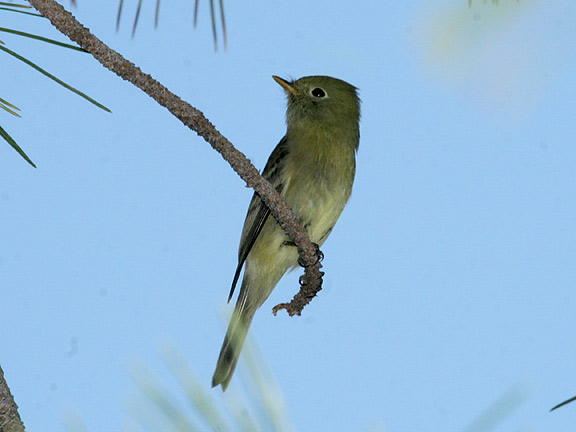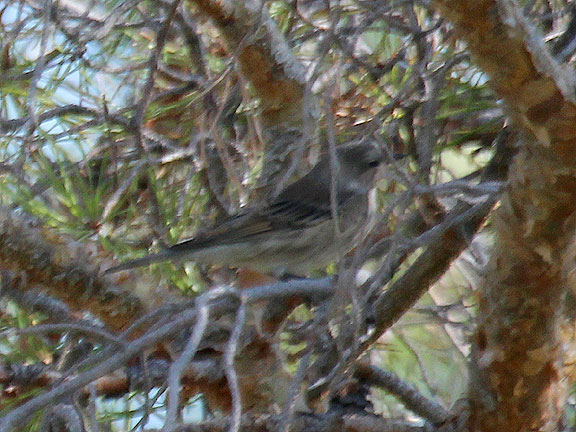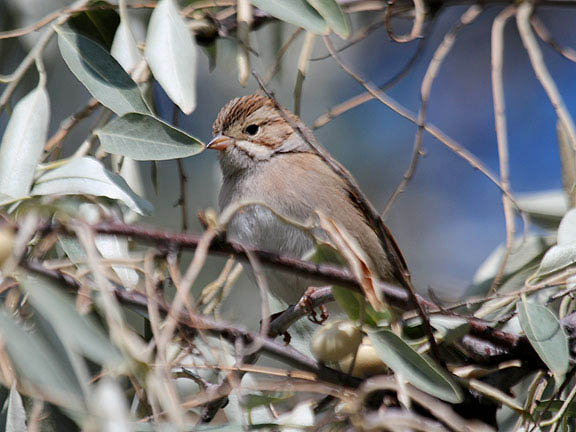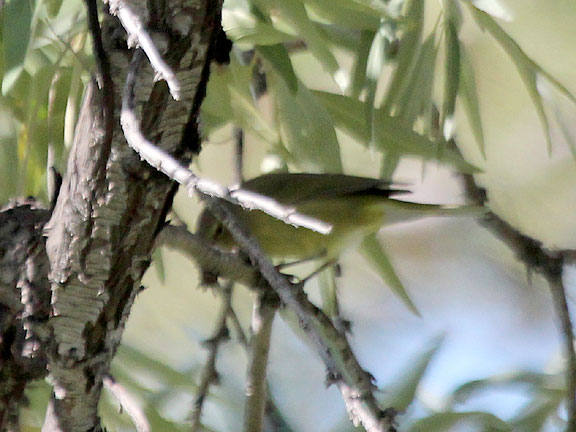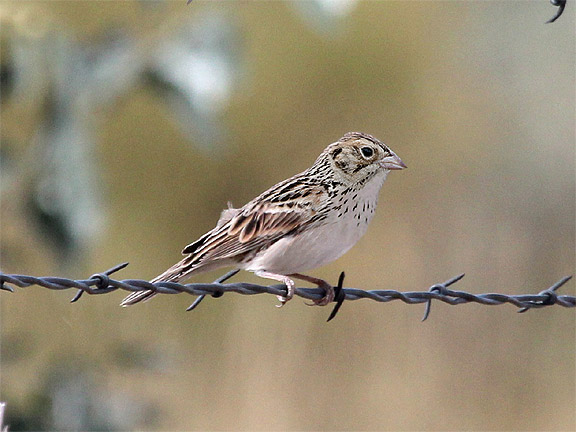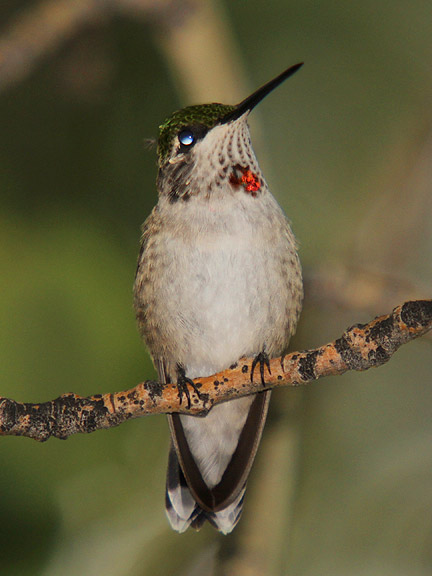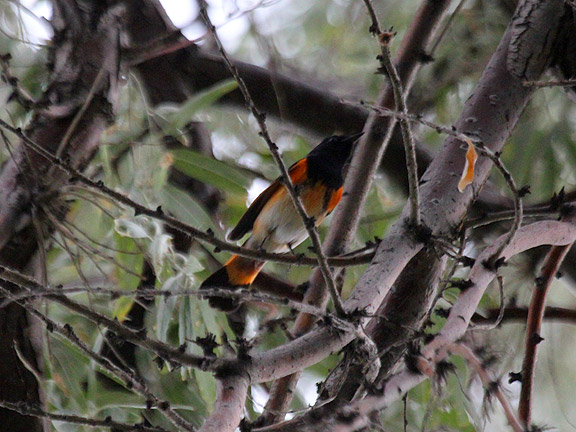
Utah Birds, Utah Birding, and Utah Birders. Promoting the sharing of information, and the conservation of habitat for birds in Utah and elsewhere. We are a group of people who want to share what we know, and create a positive birding experience in Utah.
BIRDERS BLOG
a blog by and for Utah Birders
"Yellow" House Finch
posted by Jerry Liguori at
4:46 PM
on Tuesday, September 27, 2011

Have you ever seen the "yellow variant" or "orange variant" of the House Finch? Some people call it Yellow, others call it Orange...either way, they are pretty uncommon. I have seen a few, but many birders I know have yet to see one. The only one I photographed was last winter (above), and I was pretty excited to do so. For some reason, I have always wanted to get a decent photo of this odd-colored House Finch. Anyway, not much to say, just something I've been meaning to share in case anyone wants to save the photo in their files.
Birder Profile on Birdingisfun.com
posted by Jeff Bilsky at
4:30 PM
on Friday, September 23, 2011
Birdingisfun.com is featuring me in their "Birder Profile" this week. While this will likely lead to a noticeable DECREASE in traffic to their site, I am honored! You can read it HERE
Good Birding all.
Good Birding all.
Labels: commentary
Pellets
posted by Jerry Liguori at
8:43 PM
on Monday, September 19, 2011
 People often talk about owls and hawks 'casting' pellets, but many birds cough up pellets. Songbirds and other insect-eating birds (Say's Phoebe above - click on photo to enlarge) often cast the exoskeleton remains of insects they have eaten, or regurgitate pellets made up of seed husks if they are seed eaters. Gulls and other fish-eating birds will 'spit-up' pellets as well. There are other examples, but the point is that not only raptors exhibit this behavior.
People often talk about owls and hawks 'casting' pellets, but many birds cough up pellets. Songbirds and other insect-eating birds (Say's Phoebe above - click on photo to enlarge) often cast the exoskeleton remains of insects they have eaten, or regurgitate pellets made up of seed husks if they are seed eaters. Gulls and other fish-eating birds will 'spit-up' pellets as well. There are other examples, but the point is that not only raptors exhibit this behavior.Labels: flycatchers, pellets
Let’s Call It a Smallout
posted by Tim Avery at
6:15 PM
on Saturday, September 17, 2011
As birders we hear the word fallout and immediately start
drooling about the possibilities. It’s
an event for birders, like the Kentucky Derby for Horse Racing
enthusiasts. Like a meteor shower to amateur
astronomers. Or like Halloween for Trick
or Treaters. Okay enough with the stupid
comparisons. A fallout is something that
once experienced makes all other days of birding seem somewhat mundane. Expectations of migration can become too
much, turning the most avid birder into a Grinch when they find their local
trap not producing the way a fallout does.
For most of us though, they provide some of the most exciting migration
birding around. Over Memorial Day weekend Utah experienced what I would call
the single greatest fallout of the last decade.
I can’t recall one that was more productive, turned up more rare birds,
and left many of us in awe of the sheer number of birds seen. I have a post for that coming soon. But when it comes to fallouts there are
different levels and this morning I came up with a term to describe
a mild or very location specific fallout—the “smallout”.
We were back to where we started but not anywhere near done, we started the whole loop over again and spent the next hour pouring through the birds again, adding more individuals but not new species. A few nighthawks flushed from a tree we passed a couple times previously, and a pewee popped up for good measure. Before we knew it 2 hours had passed and we had been in the same 100 yard stretch of trees. This was by all definition a fallout, but it was so localized I felt a “smallout” was a better fit for the occasion. Elsewhere at the IC we didn’t encounter anymore flocks, or anymore great finds. It was rather dead as with the first couple stops we made. It made me wonder what would have happened had we skipped that street today, or birded elsewhere first. Would the results have been the same, would the birding have been so incredible? It’s hard to say, but I sure won’t forget the great smallout of September 2011 at the IC, it was a good day to go birding.
Pictures from today's trip will be available for a couple months at the following link:
Click Here
Western Tanagers dripping from the fence at the Provo Airport
during the epic Memorial Day 2011 Fallout.
during the epic Memorial Day 2011 Fallout.
Like many other September weekend mornings I started the day
at the Salt Lake International Center. Looking at the radar last night there seemed
to be an interesting migration happening. A storm front passed through northern
Utah during the night, and as it did migrants took to the sky right on its
tail. There were not a ton of birds over
Utah, but Idaho and Nevada seemed to be getting quite a bit of activity in the
skies, so I hoped that might be a good sign. Since 2007 the International
Center has been one of the most dynamic and interesting migratory hot spots in the
state of Utah. Few birders tackle this
beast as it isn’t the typical birding locale.
It takes some patience to go birding there, and you have more than a few
disappointing outings. But what it lacks
in consistency from week to week, it makes for in what have been some amazing
finds, and a list of over 150 species recorded in just these past 5 years. Well anyways, the day started with Jeff
Bilsky and I making a stop in the southeast corner where we saw exactly zero
migrants. A few starlings, ravens, and
finches were there, leaving us thinking it was going to be another miss day. Our second stop was at the far south end of
the complex on Charles Lindbergh Drive.
This area has been a fairly productive location in past years, including
a large flock of warblers here last year that was accompanied by a
YELLOW-BELLIED FLYCATCHER. But alas,
today we had no such luck. 4 Western
Tanagers and a Wood-Pewee were nice to see, but pocket change for this locale.
Yellow-bellied Flycatcher at the IC, 09/18/10
Our third stop took us to the heart of the IC (short for
International Center), the T-intersection of Lindbergh, and the main east west thoroughfare—Amelia
Earhart Drive. This is typically the
best place to look around. Usually you
will find something here even when the rest of the place is dead. Today, it was well… dead. We found one Cassin’s Vireo, my first for the
year, and an appreciated late comer to the migration party (most have passed
through by this point). We saw a few Yellow-rumps flitting ins some trees a
ways down the road to the west, so we hopped in the car and drove to the KJZZ
building on the edge of the north pond—when the “smallout” hit us. It went from zero to 60 in a matter of minutes;
there were more birds than eyes, more species than fingers to count them
on. The movement made it almost impossible
to keep track of what you had seen, what you were seeing, and what you might
have just missed. It was chaos… It was pleasure…
It was the “smallout” of the year.
What was supposed to be an hour or so at the IC turned into
madness. Following roaming flocks of
warblers trying to pick everything else from the majority Yellow-rumps. Right
off the bat I saw the bird of the day for me; a first winter CAPE MAY
WARLER. When I first saw it all I knew is
it was slightly smaller, and sleeker than the nearby Yellow-rumps, and Cape May
was what I was hoping for. But the pesky
bird didn’t want to hold still. It was
in a foraging frenzy. This was life or
death for that bird; 1000’s of miles from its traditional migration path (even
though this is its first trip south, it sounds better that way), in a barren
desert (freshly wet from the deluge the previous night), it was on a mission to
restock its energy supply, and it didn’t care who was trying to see it. Meanwhile Jeff had wandered around the corner
out of sight. My yells were not prompting
his appearance and I was beginning to worry the bird would disappear. I wild flung my camera up at the trees and
started shooting every bit of movement I saw.
I needed a photo if it was what I thought it was. Several times I caught glimpses of the bird
as it darted form conifer, to Russian Olive, to Cottonwood, but never long
enough for the look I wanted. Later
pouring through 50 or 60 blurry, poorly lit shots, I found the golden goose egg—the
shot of the bird in its pretty plain and drab glory. It isn’t a beauty, but it sure is a fantastic
bird for Utah.
Cape May Warbler at the IC
From there we made our way west along Earhart through a line
of trees. It was crazy birding. We quickly lost count of what we were seeing,
6 species of warbler, maybe 7, or was it 8… It was hard to keep track. A Nashville here, two Townsend’s there, a
flock of 6 Wilson’s in that tree. There
goes a Warbling Vireo, a couple of Yellow Warblers chipping from nearby, and
Orange-crowned Warbler here and there—what’s that, it’s a Sparrow, but what
kind! Is it a Brewer’s? Maybe a Chipping? Wait, it’s a CLAY-COLORED SPARROW! This species has turned into an annual find
here in September, and this year would be no different. For Jeff it was a lifer, which gave us
beautiful looks for a few minutes while it fed in a Russian Olive. The birding continued…
Clay-colored Sparrow at the IC
Across the street more warblers, another mixed flock, this
one made up of all the previous species (minus the Cape May). Then a streak of
yellow through the tree in front of me, I catch a glimpse of white undertail
coverts and I reach for the camera. I
snap a couple shots not sure if I got anything, the bird was moving quickly
through the trees in front of me. I
hollered to Jeff that I thought a TENNESSEE WARBLER was in the tree. He thought he’d seen the same. Frantically looking we couldn’t find the
bird. Later a photo would confirm the
sighting, white undertail covers and all!
Tennessee Warbler at the IC
We were back to where we started but not anywhere near done, we started the whole loop over again and spent the next hour pouring through the birds again, adding more individuals but not new species. A few nighthawks flushed from a tree we passed a couple times previously, and a pewee popped up for good measure. Before we knew it 2 hours had passed and we had been in the same 100 yard stretch of trees. This was by all definition a fallout, but it was so localized I felt a “smallout” was a better fit for the occasion. Elsewhere at the IC we didn’t encounter anymore flocks, or anymore great finds. It was rather dead as with the first couple stops we made. It made me wonder what would have happened had we skipped that street today, or birded elsewhere first. Would the results have been the same, would the birding have been so incredible? It’s hard to say, but I sure won’t forget the great smallout of September 2011 at the IC, it was a good day to go birding.
Pictures from today's trip will be available for a couple months at the following link:
Click Here
Labels: fallout, migration, rare birds, salt lake county, smallout, sparrows, warblers
Cache County Big Day Results
posted by Ryan O'Donnell at
1:43 PM
on Monday, September 12, 2011
Andy watches for new species flying over the Benson Marina to roost in Cutler Marsh at dusk.
Andy Kleinhesselink and I did a Big Day in Cache County yesterday to raise money for Point Reyes Bird Observatory. We birded from 5AM to about 11PM, driving about 150 miles and hiking about 12. We also raised $154 $206 for bird conservation work at PRBO (so far - you can still donate here). Our goal was to top 100 species. We ended up shattering our goal, with 122 species! Here are some of the highlights (and lowlights), with comparison to eBird records. (There are 243 complete checklists from Cache County in eBird for September, all years, to give a sense of the sample size for an early or late record).
We did very well on waterfowl, with every expected species other than Canada Goose and Wood Duck. Best birds were a CANVASBACK at Sue's Ponds, the 2nd earliest record for the county, and a COMMON GOLDENEYE at the Polishing Ponds, a full month ahead of the earliest fall record for the county. We had at least three and possibly more HORNED GREBES at the same place, a high count for fall migration and the earliest fall record in eBird.
An early Canvasback, at right, with several Redheads at Sue's Ponds.
We didn't get many gallinaceous species, but a vocalizing flock of CHUKAR at Logan Dry Canyon was a nice find. Chukar have not been documented in eBird between July and November, but are certainly present in small numbers all year.
We did very well on raptors, including a FERRUGINOUS HAWK over Mendon and a MERLIN over Sue's Ponds. Excellent migration conditions also made it easy to pick up the common species as they drifted past the mountain ridges.
A Ferruginous Hawk flew over us as we were driving near Mendon. This species can be found all year in Cache County but it is rare here, seen on average a few times a year.
A Merlin defended its airspace over the Logan Landfill from a migrating Swainson's Hawk. This was the first Merlin I've heard of being reported in Utah this fall.
Shorebirds were tough to come by due to a shortage of habitat in the valley right now. We completely missed American Avocets, which have historically been on 10% of checklists. We did find three SOLITARY SANDPIPERS in flooded fields near the Logan Airport, a pretty high count and the latest fall record, and 25 BAIRD'S SANDPIPERS at the Polishing Ponds, the highest count on record.
We did about as expected with gulls and terns, finding the common species but no rarities except a CASPIAN TERN flying over Benson Marina at dusk.
We did very well on owls, with two GREAT HORNED OWLS, a NORTHERN SAW-WHET OWL, and a NORTHERN PYGMY-OWL calling along the road to Tony Grove before dawn. We got both the expected nightjars, COMMON NIGHTHAWK and COMMON POORWILL, with our 3-4 Poorwills in Green Canyon making the latest record in eBird.
Many flycatchers were still around. We had both EASTERN and WESTERN KINGBIRDS (with a new latest fall record for Eastern), plus OLIVE-SIDED FLYCATCHER (2nd latest fall record), WESTERN WOOD-PEWEE (latest fall record), and three empid species, DUSKY (latest fall record), HAMMOND'S, and GRAY FLYCATCHERS.
Clark's Nutcrackers were a must-have in the mountains. We saw several of this common and vocal species.
We had several WARBLING VIREOS (latest fall record). A BLUE-GRAY GNATCATCHER at Newton Reservoir was the 2nd latest fall record. We did well on warblers, including ORANGE-CROWNED, MACGILLIVRAY'S, COMMON YELLOWTHROAT, YELLOW, YELLOW-RUMPED, BLACK-THROATED GRAY (latest fall record), TOWNSEND'S, and WILSON'S. Sparrows included the second-latest fall record of FOX SPARROW, at Tony Grove.
This Fox Sparrow near Tony Grove was a bit late in starting his southbound migration.
In all, we got the vast majority of the species we expected to find plus some relatively rare species for this time of year. Across species, there were a few early records but many late records, another sign of the late fall migration this year. A heartfelt "Thank you" goes out to all of you who donated to help support our cause! Here is a complete list of the species we observed, in taxonomic order:
Gadwall
American Wigeon
Mallard
Blue-winged Teal
Cinnamon Teal
Northern Shoveler
Northern Pintail
Green-winged Teal
Canvasback
Redhead
Lesser Scaup
Common Goldeneye
Ruddy Duck
Ring-necked Pheasant
Chukar
Pied-billed Grebe
Horned Grebe
Eared Grebe
Western Grebe
Clark's Grebe
Double-crested Cormorant
American White Pelican
Great Blue Heron
Snowy Egret
White-faced Ibis
Turkey Vulture
Northern Harrier
Sharp-shinned Hawk
Cooper's Hawk
Swainson's Hawk
Red-tailed Hawk
Ferruginous Hawk
American Kestrel
Merlin
Virginia Rail
Sora
American Coot
Sandhill Crane
Killdeer
Spotted Sandpiper
Solitary Sandpiper
Baird's Sandpiper
Franklin's Gull
Ring-billed Gull
California Gull
Caspian Tern
Rock Pigeon
Eurasian Collared-Dove
Mourning Dove
Northern Saw-whet Owl
Great Horned Owl
Northern Pygmy-Owl
Common Nighthawk
Common Poorwill
Black-chinned Hummingbird
Williamson's Sapsucker
Red-naped Sapsucker
Downy Woodpecker
Hairy Woodpecker
Northern Flicker
Olive-sided Flycatcher
Western Wood-Pewee
Hammond's Flycatcher
Gray Flycatcher
Dusky Flycatcher
Western Kingbird
Eastern Kingbird
Warbling Vireo
Steller's Jay
Black-billed Magpie
Clark's Nutcracker
American Crow
Common Raven
Northern Rough-winged Swallow
Violet-green Swallow
Barn Swallow
Black-capped Chickadee
Mountain Chickadee
Red-breasted Nuthatch
Brown Creeper
Canyon Wren
Marsh Wren
Blue-gray Gnatcatcher
American Dipper
Ruby-crowned Kinglet
Townsend's Solitaire
Hermit Thrush
American Robin
Gray Catbird
European Starling
Cedar Waxwing
Orange-crowned Warbler
MacGillivray's Warbler
Common Yellowthroat
Yellow Warbler
Yellow-rumped Warbler
Black-throated Gray Warbler
Townsend's Warbler
Wilson's Warbler
Green-tailed Towhee
Spotted Towhee
Chipping Sparrow
Brewer's Sparrow
Vesper Sparrow
Savannah Sparrow
Fox Sparrow
Song Sparrow
Lincoln's Sparrow
White-crowned Sparrow
Dark-eyed Junco
Western Tanager
Black-headed Grosbeak
Lazuli Bunting
Red-winged Blackbird
Yellow-headed Blackbird
Brewer's Blackbird
Cassin's Finch
House Finch
Red Crossbill
Pine Siskin
American Goldfinch
House Sparrow
Gunsight Peak from Benson Marina in the evening. We watched for birds to come into roost here as the daylight faded.
Labels: big day, Cache County, migration
September 7th to 14th - Rarity Week in Utah?
posted by Tim Avery at
10:41 PM
on Saturday, September 10, 2011
The 2nd week in September is a good week to go birding in Utah. The same can pretty much be said across the United States--this is the height of migration. With the best week of birding come so great birds and I have had a string of good luck past years during this time. This year was no exception.
On Friday the 9th I found a Baird's Sparrow at Swede Lane in Utah County. Today I had a Ruby-throated Hummingbird at my feeder (ironically a year to the day from a sighting of the same thing at my house). With rarities on my mind I decided to take a look into eBird and see what I personally had recorded during this week over the past few years. Here's the list:
2011:
09/10/11 - Ruby-throated Hummingbird (Sandy, SL County)
09/09/11 - Baird's Sparrow (Sweded Lane, Utah County)
2010:
09/10/10 - Ruby-throated Hummingbird (Sandy,SL County)
2009:
09/07/09 - Scarlet Tanager (International Center, SL County)
2008:
09/12/08 - Magnolia Warbler (Magna, SL County)
2007:
09/09/07 - Black-and-white Warbler (Garr Ranch, Davis County)
09/08/07 - Prothonotary Warbler (International Center, SL County)
2006: I was out of state
2005:
09/11/05 - Wandering Tattler (AIC, Davis County)
09/11/05 - Parasitic Jaeger (Willard Bay, Box Elder County)
And those are just sightings by me. I am sure if I ran the report in eBird that list would be 25 times as long. I could probably pull similar information for other weeks, but the 2nd week in particular seems to be the winner.
Baird's Sparrow at Swede Lane - 09/09/11
2011:
09/10/11 - Ruby-throated Hummingbird (Sandy, SL County)
09/09/11 - Baird's Sparrow (Sweded Lane, Utah County)
2010:
09/10/10 - Ruby-throated Hummingbird (Sandy,SL County)
2009:
09/07/09 - Scarlet Tanager (International Center, SL County)
2008:
09/12/08 - Magnolia Warbler (Magna, SL County)
2007:
09/09/07 - Black-and-white Warbler (Garr Ranch, Davis County)
09/08/07 - Prothonotary Warbler (International Center, SL County)
2006: I was out of state
2005:
09/11/05 - Wandering Tattler (AIC, Davis County)
09/11/05 - Parasitic Jaeger (Willard Bay, Box Elder County)
And those are just sightings by me. I am sure if I ran the report in eBird that list would be 25 times as long. I could probably pull similar information for other weeks, but the 2nd week in particular seems to be the winner.
Ruby-throated Hummingbird, Sandy, Utah - 09/10/11
So even though the birding in general hasn't been too hot this month, it is still a great time to find something incredible. Keep you eyes to the skies and you may see something great!
Labels: hummingbirds, rare birds, sparrows
Cache County Big Day Fundraiser
posted by Ryan O'Donnell at
2:10 PM
on Friday, September 9, 2011
This weekend Andy Kleinhesselink, Andrew Durso, and I are going to do a Big Day in Cache County, Utah as a fundraiser for the Point Reyes Bird Observatory. PRBO is a non-profit organization dedicated to the study and conservation of birds around North America. If you believe that bird conservation is important, please consider donating a few dollars to help sponsor our team. All funds raised go directly to PRBO (we are covering our own costs). To donate, visit this secure online donation site. Even a dollar or two would be a big help towards our very modest goal of raising $200.
Thank you very much, from us and the birds.
Thank you very much, from us and the birds.
Nocturnal Migration Over America
posted by Tim Avery at
10:50 PM
on Thursday, September 8, 2011
As we approach the height of fall migration it isn't surprising to look at the national radar map and see blobs of green and blue all over the country--especially to the east of the Rockies. I just screen captured the image below from about 10:30pm MT (so just after midnight on the east coast):
Even over the sparsely populated west you can see the radar sites are showing reflectivity--but nothing like what's going on back east. This is a fairly normal though, as we don't usually see anything like what happens over places like Chicago, St. Louis, Indianapolis, and the rest of those blobs you see above.
That being said, we are still not seeing the effects of any sizeable movement in northern Utah. Small numbers of migrants are trickling through, but overall it's still lackluster. I don't know what the next week or so holds; I had hoped a small front would be passing through this weekend and maybe bring some birds with it, but it doesn't look like much will be happening.
The best advice, just get out in the field and keep looking. Eventually something will change and the birding will improve. Even if you don't see lots of birds, fun stuff always turns up like this American Redstart from Garr Ranch on Monday:
See Live Map: http://www.weather.gov/radar_tab.php
Even over the sparsely populated west you can see the radar sites are showing reflectivity--but nothing like what's going on back east. This is a fairly normal though, as we don't usually see anything like what happens over places like Chicago, St. Louis, Indianapolis, and the rest of those blobs you see above.
That being said, we are still not seeing the effects of any sizeable movement in northern Utah. Small numbers of migrants are trickling through, but overall it's still lackluster. I don't know what the next week or so holds; I had hoped a small front would be passing through this weekend and maybe bring some birds with it, but it doesn't look like much will be happening.
The best advice, just get out in the field and keep looking. Eventually something will change and the birding will improve. Even if you don't see lots of birds, fun stuff always turns up like this American Redstart from Garr Ranch on Monday:
American Redstart at Garr Ranch
Labels: migration, night migration, warblers
Not Birds: Spiders of Utah
posted by Ryan O'Donnell at
4:11 PM
A Platycryptus sp. jumping spider on a wall in Logan, Utah. ©Ryan O'Donnell and Stephanie Cobbold, 2011.
Would you like to learn more about spiders, in Utah and around the world? Stephanie Cobbold's PhD dissertation is on some of the spiders of Utah. Lately we've been taking lots of spider photos, and she's been sharing some of them at her blog. Check it out!Labels: blogging, identification, spiders

